News
How to design irregular shape PCB
How to design irregular shape PCB
The complete PCB we envision is usually a regular rectangular shape. While most designs are indeed rectangular, many designs require irregularly shaped boards that are often not easily designed. This article describes how to design an irregularly shaped PCB.
Today, PCBs are shrinking in size, and the functionality in boards is increasing, and as clock speeds increase, designs become more complex. So let's see how to handle more complex boards.
As shown in Figure 1, a simple PCI board shape can be easily created in most EDA Layout tools.
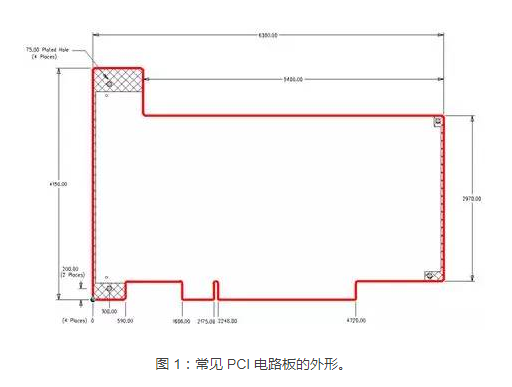
However, when the board shape needs to accommodate a complex housing with a high degree of limitation, it is not so easy for PCB designers because the functions in these tools are not the same as those of a mechanical CAD system. The complex circuit board shown in Figure 2 is mainly used for explosion-proof housings and is therefore subject to many mechanical limitations. Rebuilding this information in the EDA tool can take a long time and is not effective. Because it is very likely that mechanical engineers have created the enclosures, board shapes, mounting hole locations, and height limitations that PCB designers need.
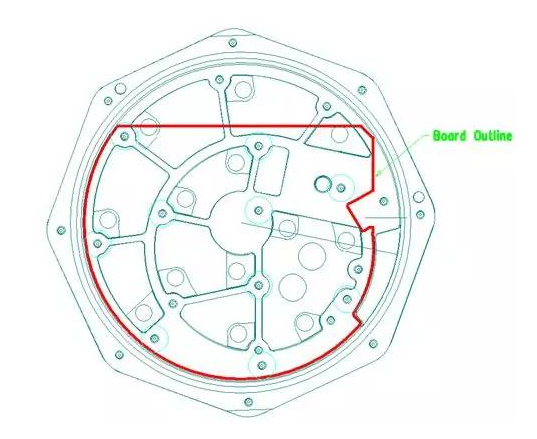
Because of the curvature and radius in the board, even if the board shape is not complicated (as shown in Figure 3), the reconstruction time may be longer than expected.
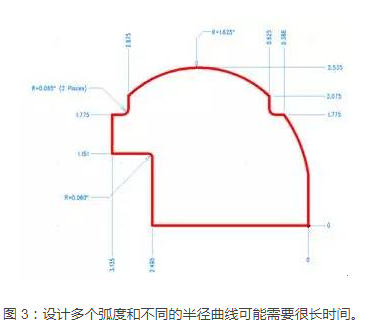
These are just a few examples of complex board shapes. However, from today's consumer electronics, you will be surprised to find that many projects attempt to include all the features in a small package that is not always rectangular. Your first thoughts should be on smartphones and tablets, but there are many similar examples.
If you return a rented car, you may see the waiter read the car information with a handheld scanner and then communicate wirelessly with the office. The device is also connected to a thermal printer for instant receipt printing. In fact, all of these devices use rigid/flexible boards (Figure 4) where traditional PCB boards are interconnected with flexible printed circuits to allow for folding into small spaces.
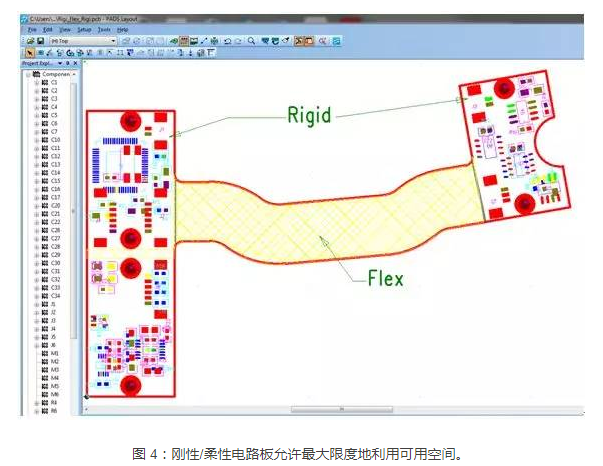
So the question is “How do you import a defined mechanical engineering specification into a PCB design tool?” Reusing this data in a mechanical drawing eliminates duplication and, more importantly, eliminates human error.
We can solve this problem by importing all information into the PCB Layout software using the DXF, IDF or ProSTEP format. Doing so saves a lot of time and eliminates human error that can occur. Next, we will understand each of these formats one by one.
DXF is one of the oldest and most widely used formats for electronically exchanging data between mechanical and PCB design domains. AutoCAD was developed in the early 1980s. This format is mainly used for two-dimensional data exchange. Most PCB tool vendors support this format, and it does simplify data exchange. DXF import/export requires additional functionality to control the layers, different entities, and units that will be used during the exchange process. Figure 5 is an example of importing a very complex board shape in DXF format using Mentor Graphics' PADS tool:
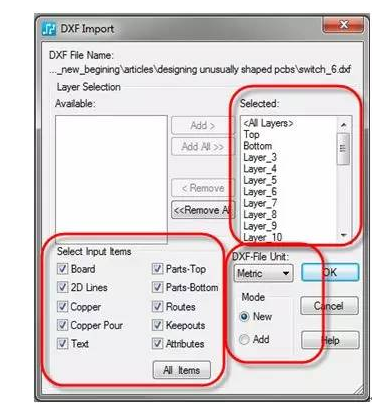
A few years ago, 3D functionality began to appear in PCB tools, so a format was needed to transfer 3D data between mechanical and PCB tools. As a result, Mentor Graphics developed the IDF format, which was later widely used to transfer board and component information between PCBs and machine tools.
Although the DXF format includes board size and thickness, the IDF format uses the X and Y positions of the component, the component tag number, and the Z-axis height of the component. This format greatly improves the ability to visualize PCBs in 3D views. Additional information about the exclusion zone may be included in the IDF file, such as height limits at the top and bottom of the board.
The system needs to be able to control what will be included in the IDF file in a similar way to the DXF parameter settings, as shown in Figure 6. If some components do not have height information, IDF export can add missing information during the creation process.
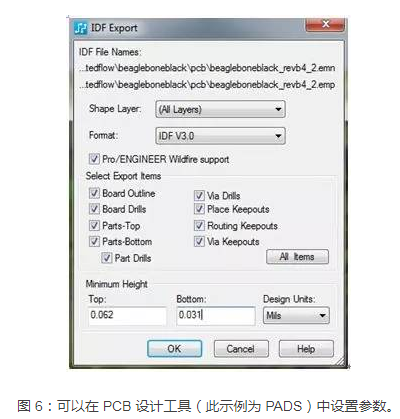
Another advantage of the IDF interface is that either party can move components to a new location or change the board shape and create a different IDF file. The disadvantage of this approach is that the entire file representing board and component changes needs to be re-imported, and in some cases it may take a long time due to file size. In addition, it is difficult to determine what changes have been made with the new IDF file, especially on larger boards. IDF users can eventually create custom scripts to determine these changes.
In order to better transmit 3D data, designers are looking for an improved way, the STEP format came into being. The STEP format can transfer board size and component layout, but more importantly, components no longer have a simple shape with only height values. The STEP component model provides a detailed and complex representation of the component in three dimensions. Board and component information can be transferred between the PCB and the machine. However, there is still no mechanism to track changes.
To improve the exchange of STEP files, we introduced the ProSTEP format. This format moves the same data as IDF and STEP and has been greatly improved – it can track changes, as well as provide the ability to work in the discipline's original system and review any changes after benchmarking. In addition to viewing changes, PCB and mechanical engineers can approve all or individual component changes in layout, board shape modifications. They can also suggest different board sizes or component locations. This improved communication creates an ECO (Engineering Change Order) that has never existed before between ECAD and the mechanical group (Figure 7).

Most ECAD and mechanical CAD systems now support the use of the ProSTEP format to improve communication, saving significant time and reducing the costly mistakes of complex electromechanical designs. More importantly, engineers can create a complex board shape with additional constraints and then pass this information electronically to avoid someone erroneously reinterpreting the board size to save time.
If you have not used these DXF, IDF, STEP or ProSTEP data formats to exchange information, you should check their usage. Consider using this electronic data exchange to stop wasting time to recreate complex board shapes.
Categories
Latest News
Contact Us
Contact: Ms Tracy
Phone:
Tel:
Add: BludingA,Shixiaganglian Industrial Park,Shajing,Baoan,Shenzhen,China
 Tracy
Tracy